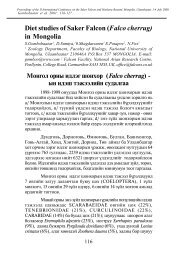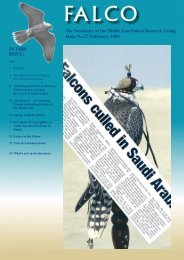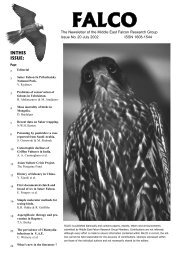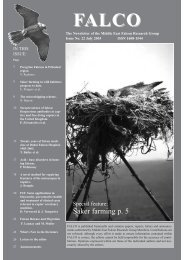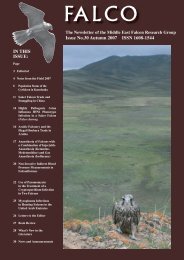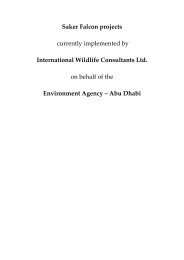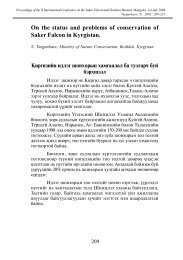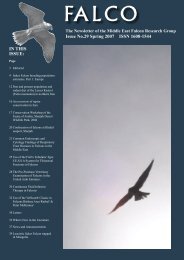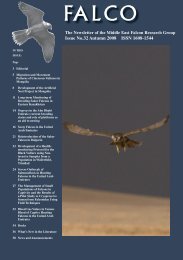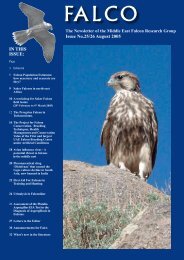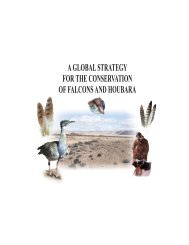Falco 28 - International Wildlife Consultants Ltd.
Falco 28 - International Wildlife Consultants Ltd.
Falco 28 - International Wildlife Consultants Ltd.
Create successful ePaper yourself
Turn your PDF publications into a flip-book with our unique Google optimized e-Paper software.
Notes from the field in 2006<br />
Andrew Dixon<br />
<strong>International</strong> <strong>Wildlife</strong> <strong>Consultants</strong> (UK) <strong>Ltd</strong>, P.O. Box 19,<br />
Carmarthen, SA33 5YL. UK<br />
falco@falcons.co.uk<br />
Introduction<br />
The Environment Agency of Abu Dhabi has continued<br />
to fund research on wild Saker <strong>Falco</strong>n populations in<br />
2006 with projects being carried out in several regions<br />
across the extensive Eurasian breeding range of the<br />
species. What follows is a brief resume of the work<br />
that has been undertaken this season on a country-bycountry<br />
basis. Much of the data has only just been<br />
collated and has yet to be analysed, whilst at the time<br />
of writing radio-tracking studies are still underway.<br />
Mongolia<br />
Research in Mongolia is undertaken in collaboration<br />
with Dr. Gombobaatar Sundev of the National University<br />
of Mongolia. The university field team included Prof.<br />
Sumiya and students from the Faculty of Biology:<br />
Odkhuu, Zaya (both post-graduate masters students),<br />
Tulga and Amraa (both under-graduate students). This<br />
year research was again based in one large study area<br />
in the central Mongolian steppe.<br />
Work continued on the use of artificial nesting sites<br />
by Sakers. The artificial nest platforms have now been<br />
in place for four breeding seasons but unfortunately<br />
the Brant’s Voles in the area were poisoned with<br />
Bromodialone prior to the 2003 breeding season.<br />
Consequently the small mammal population of the area<br />
was decimated and has yet to recover. The artificial<br />
platforms provide a substrate for ‘founder species’ such<br />
as Upland Buzzard and Raven to build nests, which can<br />
then be usurped by Saker <strong>Falco</strong>ns. In 2006, the number<br />
of breeding Sakers using the artificial platforms dropped<br />
to a single pair, whilst the number of Upland Buzzards<br />
has crashed from 29 breeding pairs to 3 over the four<br />
years of study. In contrast the number of breeding Ravens<br />
has remained relatively constant. Despite the fact that<br />
the Brandt’s Vole densities have been consistently low<br />
over the study period the level of artificial platform<br />
occupancy suggests that there is a strong relationship<br />
between vole density and the number of breeding<br />
pairs of Upland Buzzards. Whether the breeding<br />
Saker <strong>Falco</strong>ns exhibit such a strong relationship is<br />
not so clear from the small number of pairs that have<br />
occupied the platforms over the study period; there are<br />
other factors that could have influenced the number of<br />
Sakers breeding at the artificial platforms such as nest<br />
availability and the use of alternative sites on a nearby<br />
electricity line.<br />
Figure 1. Young Saker <strong>Falco</strong>ns at a nest on an artificial<br />
platform.<br />
Upland Buzzards are specialist predators that feed to a<br />
large extent on small mammals such as Brandt’s Voles,<br />
whereas Saker <strong>Falco</strong>ns can exploit a wider range of<br />
prey species from mammals to birds and Ravens are<br />
true generalists. In autumn 2003 we established a new<br />
grid of 99 artificial nests that did not require a founder<br />
nest to be built before they were suitable for occupancy<br />
by Sakers. At these artificial nests 19 were occupied<br />
by Upland Buzzards that built nests, 2 were occupied<br />
by Sakers and 7 were occupied by Ravens that built<br />
nests; the number of pairs that actually laid eggs was<br />
7, 2 and 5 respectively. The breeding rate of Upland<br />
Buzzards shows the classic response to food supply of a<br />
vole specialist feeder such that only a small proportion<br />
of birds that formed pairs and built nests actually<br />
attempted to breed. The 99 artificial nests cover an area<br />
of 324 km 2 and could easily accommodate more than<br />
two breeding pairs of Saker <strong>Falco</strong>ns. Clearly, some<br />
factor other than nest site availability limited the level<br />
of occupancy at these artificial nests and the most likely<br />
explanation is that food supply was the limiting factor.<br />
Across the extensive plains of the Mongolian steppe it<br />
is likely that many, if not most, areas it is food supply<br />
that will limit Saker <strong>Falco</strong>n breeding densities at a low<br />
level and the provision of artificial nest sites is unlikely<br />
to increase these densities significantly.<br />
We still do not know how the breeding population of<br />
Saker <strong>Falco</strong>ns responds to changes in Brandt’s Vole<br />
numbers. Intuitively we predict that an increase in<br />
prey biomass will result in an increase in the breeding<br />
population in our artificial nest area. Unfortunately,<br />
the factors that regulate population explosions in the<br />
10



